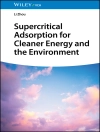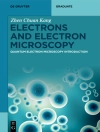The leading resource for anyone looking for an accessible and authoritative introduction to nuclear and radiochemistry
In the newly revised Fourth Edition of Nuclear and Radiochemistry: Fundamentals and Applications, distinguished chemist Jens-Volker Kratz delivers a two-volume handbook that has become the gold standard in teaching and learning nuclear and radiochemistry. The books cover the theory and fundamentals of the subject before moving on the technical side of nuclear chemistry, with coverage of nuclear energy, nuclear reactors, and radionuclides in the life sciences.
This latest edition discusses the details and impact of the Chernobyl and Fukushima nuclear disasters, as well as new research facilities, including FAIR and HIM. It also incorporates new methods for target preparation and new processes for nuclear fuel recycling, like EURO-GANEX. Finally, the volumes extensively cover environmental technological advances and the effects of radioactivity on the environment.
Readers will also find:
– An accessible and thorough introduction to the fundamental concepts of nuclear physics and chemistry, including atomic processes, classical mechanics, relativistic mechanics, and the Heisenberg Uncertainty Principle
– Comprehensive explorations of radioactivity in nature, radioelements, radioisotopes and their atomic masses, and other physical properties of nuclei
– Practical discussions of the nuclear force, nuclear structure, decay modes, radioactive decay kinetics, and nuclear radiation
– In-depth examinations of the statistical considerations relevant to radioactivity measurements
Written for practicing nuclear chemists and atomic physicists, Nuclear and Radiochemistry: Fundamentals and Applications is also an indispensable resource for nuclear physicians, power engineers, and professionals working in the nuclear industry.
表中的内容
1 Fundamental Concepts
1.1 The Atom
1.2 Atomic Processes
1.3 Discovery of the Atomic Nucleus
1.4 Nuclear Decay Types
1.5 Some Physical Concepts Needed in Nuclear Chemistry
1.5.1 Fundamental Forces
1.5.2 Elements from Classical Mechanics
1.5.3 Relativistic Mechanics
1.5.4 The de Broglie Wavelength
1.5.5 Heisenberg Uncertainty Principle
1.5.6 The Standard Model of Particle Physics
1.5.7 Force Carriers
2 Radioactivity in Nature
2.1 Discovery of Radioactivity
2.2 Radioactive Substances in Nature
2.3 Nuclear Forensics
3 Radioelements and Radioisotopes and Their Atomic Masses
3.1 Periodic Table of the Elements
3.2 Isotopes and the Chart of Nuclides
3.3 Nuclide Masses and Binding Energies
3.4 Evidence for Shell Structure in Nuclei
3.5 Precision Mass Spectrometry
4 Other Physical Properties of Nuclei
4.1 Nuclear Radii
4.2 Nuclear Angular Momenta
4.3 Magnetic Dipole Moments
4.4 Electric Quadrupole Moments
4.5 Statistics and Parity
4.6 Excited States
5 The Nuclear Force and Nuclear Structure
5.1 Nuclear Forces
5.2 Charge Independence and Isospin
5.3 Nuclear Matter
5.4 Fermi Gas Model
5.5 Shell Model
5.6 Collective Motion in Nuclei
5.7 Nilsson Model
5.8 The Pairing Force and Quasi-Particles
5.9 Macroscopic-Microscopic Model
5.10 Interacting Boson Approximation
5.11 Further Collective Excitations: Coulomb Excitation, High-Spin States, Giant Resonances
6 Decay Modes
6.1 Nuclear Instability and Nuclear Spectroscopy
6.2 Alpha Decay
6.2.1 Hindrance Factors
6.2.2 Alpha-Decay Energies
6.3 Cluster Radioactivity
6.4 Proton Radioactivity
6.5 Spontaneous Fission
6.6 Beta Decay
6.6.1 Fundamental Processes
6.6.2 Electron Capture-to-Positron Ratios
6.6.3 Nuclear Matrix Elements
6.6.4 Parity Non-conservation
6.6.5 Massive Vector Bosons
6.6.6 Cabibbo-Kobayashi-Maskawa Matrix
6.7 Electromagnetic Transitions
6.7.1 Multipole Order and Selection Rules
6.7.2 Transition Probabilities
6.7.3 Internal Conversion Coefficients
6.7.4 Angular Correlations
7 Radioactive Decay Kinetics
7.1 Law and Energy of Radioactive Decay
7.2 Radioactive Equilibria
7.3 Secular Radioactive Equilibrium
7.4 Transient Radioactive Equilibrium
7.5 Half-life of Mother Nuclide Shorter than Half-life of Daughter Nuclide
7.6 Similar Half-lives
7.7 Branching Decay
7.8 Successive Transformations
8 Nuclear Radiation
8.1 General Properties
8.2 Heavy Charged Particles
8.3 Beta Radiation
8.4 Gamma Radiation
8.5 Neutrons
8.6 Short-lived Elementary Particles in Atoms and Molecules
9 Measurement of Nuclear Radiation
9.1 Activity and Counting Rate
9.2 Gas-Filled Detectors
9.2.1 Ionization Chambers
9.2.2 Proportional Counters
9.2.3 Geiger-Müller Counters
9.3 Scintillation Detectors
9.4 Semiconductor Detectors
9.5 Choice of Detectors
9.6 Spectrometry
9.7 Determination of Absolute Disintegration Rates
9.8 Use of Coincidence and Anticoincidence Circuits
9.9 Low-Level Counting
9.10 Neutron Detection and Measurement
9.11 Track Detectors
9.11.1 Photographic Emulsions and Autoradiography
9.11.2 Dielectric Track Detectors
9.11.3 Cloud Chambers
9.11.4 Bubble Chambers
9.11.5 Spark Chambers
9.12 Detectors Used in Health Physics
9.12.1 Portable Counters and Survey Meters
9.12.2 Film Badges
9.12.3 Pocket Ion Chambers
9.12.4 Thermoluminescence Dosimeters
9.12.5 Contamination Monitors
9.12.6 Whole-Body Counters
10 Statistical Considerations in Radioactivity Measurements
10.1 Distribution of Random Variables
10.2 Probability and Probability Distributions
10.3 Maximum Likelihood
10.4 Experimental Applications
10.5 Statistics of Pulse-Height Distributions
10.6 Setting Upper Limits When No Counts Are Observed
11 Techniques in Nuclear Chemistry
11.1 Special Aspects of the Chemistry of Radionuclides
11.1.1 Short-Lived Radionuclides and the Role of Carriers
11.1.2 Radionuclides of High Specific Activity
11.1.3 Microamounts of Radioactive Substances
11.1.4 Radiocolloids
11.1.5 Tracer Techniques
11.2 Target Preparation
11.3 Measuring Beam Intensity and Fluxes
11.4 Neutron Spectrum in Nuclear Reactors
11.4.1 Thermal
关于作者
Jens-Volker Kratz is a retired Professor of Nuclear Chemistry at Johannes Gutenberg University in Mainz, Germany. He obtained his degrees in Chemistry at this university, followed by postdoctoral research with Glenn T. Seaborg at Berkeley. Before moving back to Mainz, he worked as a group leader between 1974 and 1982 at GSI in Darmstadt. He has published 350 scientific articles and two editions of this textbook. For 24 years, he served as editor of Radiochimica Acta. He was nominated Fellow of the International Union of Pure and Applied Chemistry and has received numerous prizes, including the Otto Hahn Award.












